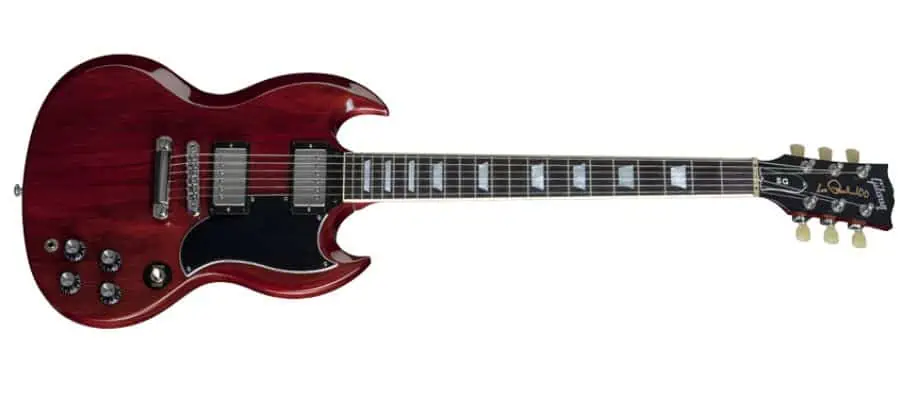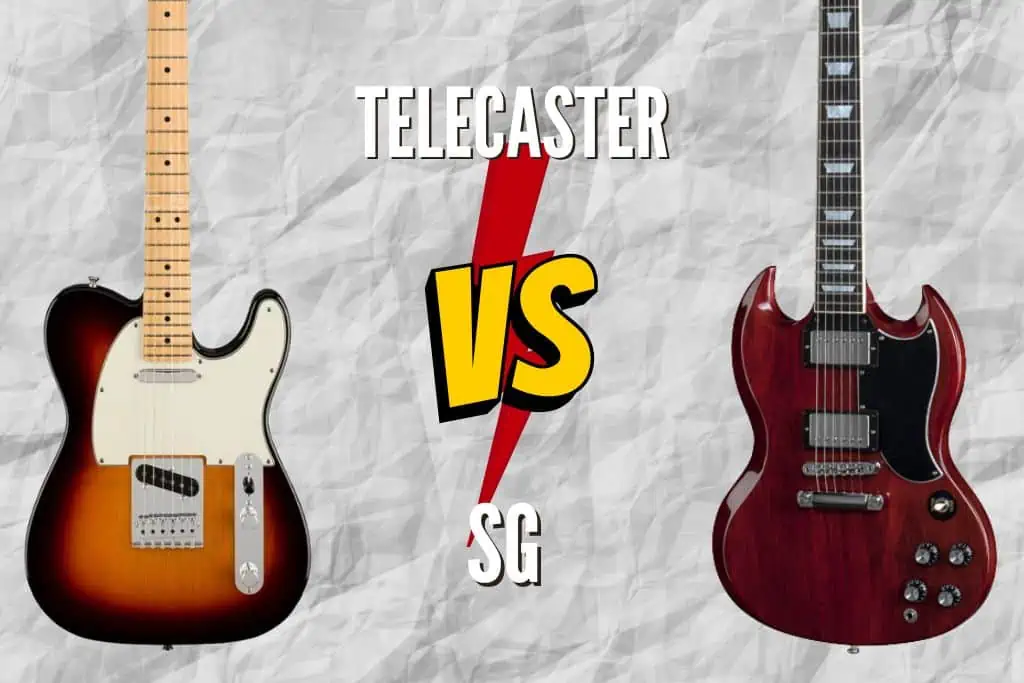Among many other guitar models, the two of the most iconic and easily recognizable electric guitars in the world are the Fender Telecaster and the Gibson SG. Both guitars have been used by some of the biggest names in music history and have played a crucial role in defining the sound of rock ‘n’ roll. While they may seem similar at first glance, the Telecaster and SG have a number of differences in construction, tone, feel, and looks.
One of the main differences between the SG and Telecaster is their construction. The Telecaster has a solid body made of alder or ash wood with a bolt-on neck, while the SG has a solid mahogany body and neck that are glued together. The SG is also thinner and lighter than the Telecaster, making it more comfortable to play for extended periods of time.
The Telecaster typically has one or two single-coil pickups, while the SG has two humbucking pickups. This gives the SG a warmer, more distorted sound that is perfect for heavy rock and metal music, while the Telecaster’s bright, twangy tone is ideal for country, rockabilly, and blues.
Both guitars are known for their unique feel and playability. The Telecaster has a wider neck that can be more comfortable for players with larger hands, while the SG has a thinner neck that is ideal for players with smaller hands. The Telecaster’s bolt-on neck makes it easier to repair or replace, while the SG’s glued-on neck provides more stability and resonance.
| Telecaster | SG | |
| Body Shape | Tele-style | SG Standard |
| Body Wood | Alder | Mahagony |
| Neck Shape | Deep C | Rounded |
| Neck Wood | Maple | Mahagony |
| Neck Construction | Bolt-on | Set Neck |
| Fretboard Material | Maple | Rosewood |
| Scale Length | 25.5″ | 24.75″ |
| Number Of Frets | 22, Narrow Tall | 22, Medium Jumbo |
| Frets Material | Nickel Silver | Nickel Silver |
| Type of Bridge | 2-Point Synchronized Tremolo with Cold-rolled Steel Block | Nashville Tune-O-Matic with Stopbar |
| Tuning Machines | Fender Standard Die-cast | Grover Rotomatics |
| Pickups | 3 x Fender V-Mod II Single-coil | Dual 490R and 490T Humbuckers |
| Weight | 8.5 lbs (3.85 kg) | 6 lbs (2.7 kg) |
Gibson and Fender’s guitars are known for creating great quality instruments at any price point, from extremely cheap to outrageously expensive. Yet, all of their products share the same attribute. That is that they are among the best in the category, if not the best. Throughout this article, we will do our best to go over the main differences that define these two “classic” electric guitar models.
Construction & Hardware Compared

The Telecaster has a classic design, with a solid body made from either alder or ash wood. It has a bolt-on neck and a simple design, with one or two single-coil pickups. The Telecaster is known for its simplicity and durability, with a design that has remained largely unchanged since its inception in the 1950s.
On the other hand, the Gibson SG has a more complex design, with a solid mahogany body and neck that are glued together. It typically has two humbucking pickups, which produce a warmer, more distorted sound than the Telecaster’s single-coil pickups. The SG also has a thinner body than the Telecaster, making it easier to play for extended periods of time.
The Telecaster’s bolt-on neck makes it easier to repair or replace, and its simple design makes it easier to maintain. However, it may be less stable and less resonant than the SG’s glued-on neck, and its simpler bridge design may not offer the same level of sustain or tuning stability as the SG’s more complex bridge design.
Tone Compared

The Telecaster is known for its bright, twangy tone, which is perfect for country, rockabilly, and blues music. Its single-coil pickups produce a clear, articulate sound that is perfect for rhythm guitar playing, although it may not be the best choice for heavy distortion or high-gain styles of music.
The SG, on the other hand, produces a warmer, thicker sound that is ideal for heavy rock and metal music. Its humbucking pickups produce a more distorted, aggressive sound that is perfect for soloing and lead guitar playing. The SG’s thicker, heavier body also contributes to its powerful sound, giving it a strong low-end that is perfect for drop-tuned or downtempo music.
Feel & Playability Compared

When it comes to feel and playability, both guitars have their own unique qualities. The Telecaster has a wider neck that can feel more comfortable for players with larger hands, while the SG has a thinner neck that is more comfortable for players with smaller hands. The SG also has a more contoured body shape, which can make it easier to play in a seated position.
The Telecaster’s bolt-on neck gives it a slightly brighter sound than the SG, but it can also make it slightly less resonant than the SG’s glued-on neck. The Telecaster’s bridge is also more simplistic than the SG’s, which can make it easier to maintain and adjust, but may not offer the same level of sustain or tuning stability as the SG’s more complex bridge design.
Looks Compared
Finally, both the Telecaster and SG have their own unique aesthetic qualities that make them stand out in their own right.

The Telecaster’s classic, vintage look has remained largely unchanged since its introduction in the 1950s. Its simple design and bright color options, such as the iconic Butterscotch Blonde and Olympic White, make it a popular choice for players who want a guitar that looks as good as it sounds.

The SG, on the other hand, has a more modern, edgy look that is perfect for players who want to stand out on stage. Its sleek, contoured body shape and dark color options give it a distinctive look that is sure to turn heads. You will usually see this guitar in its iconic cherry red finish which you can see used by many popular guitarists. Perhaps one of the more significant ambassadors of this guitar model is no other than Angus Young, the lead guitarist of AC/DC.
Conclusion
In the end, the choice between the Telecaster and SG comes down to personal preference. Both guitars have their own unique characteristics and tonal qualities that make them ideal for different styles of music and playing styles. The Telecaster’s simple design and bright, twangy tone are perfect for country and rockabilly music, while the SG’s thicker, heavier sound and sleek, modern look are ideal for heavy rock and metal music.
Ultimately, the decision between these two iconic guitars should be based on your individual preferences and playing style, so be sure to try them both out before making a final decision. Whichever guitar you choose, both the Telecaster and SG are sure to provide a lifetime of musical inspiration and enjoyment.
If you found this article useful, you may want to save this pin below to your Guitar board.

Recent Posts
When learning new songs have you noticed that some of the chord sequences sound really good? But when you tried to come up with your own chord sequence, or as we call it chord progression, you found...
Some guitarists insist on buying an expensive amplifier with their electric guitar. They assume that this is a must for every type of guitarist out there. However, in some situations, this isn’t...

